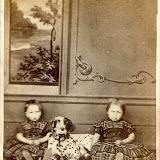Photographs of children from the Victorian age
“He walks shockingly and is dreadfully awkward, holds himself as badly as ever and his manners are despairing, as well as his speech, which is quite dreadful. It is so provoking as he learns so well and reads quite fluently; but his French is more like Chinese than anything else; poor child, he is really very unfortunate."
Queen Victoria describing her son, Leopold, in 1859
I had a kind of Dickensian childhood.
Shaun Cassidy
Pity Lewis Carroll. It is his tragedy that no one can discuss him without raising the spectre of paedophilia. A tragedy because the evidence is unresolved so it continues to haunt his reputation; tragic too because people are inclined to read a sinister eroticism into some of his portraits merely because the subject is a young girl. And it gets worse. What is often deemed dangerous, at least unsettling, in Carroll’s portraits could be nothing more harmless than girls playing dress-ups. Meanwhile some of his contemporaries, Oscar Rejlander for one, have escaped scrutiny for works of much more deliberate salacity.
Alice is the most well adjusted child in Victorian literature, encountering the various characters she meets in Wonderland with unruffled maturity and commonsense. Then again she hasn’t suffered the litany of horrors usually dumped on her contemporaries, Pip in Great Expectations, Tom the chimney-sweep in The Water Babies and all those other children adrift in the world without parents, raised in the workhouse or cut down by disease. For a lot of us, our first impressions of the Victorian era were formed when some well meaning relative gave us a copy of A Christmas Carol or Oliver Twist and plunged us into a world of unrelieved miseries. Even now, with a few years of accumulated knowledge behind us, it’s hard to imagine London in the 1860s washed in sunlight and alive with the sounds of chuckling infants. It was grim, the air was filthy and children battled through unloved and abused. No wonder they seldom smiled for the camera.
Newspapers provide convincing evidence that life was actually as bad as that. In 1862 a Dr Greenhow discovered that three quarters of children born to Nottingham factory workers died in infancy, that at a time when one in four children in England died in their first year. Overlooking the frequent reports of murders and neglect that happen as much today, we have the stories of child labourers. A story from the New York Times in November 1875 describes a group of spectators so disgusted by the treatment handed out to one of ‘Count Leo’s’ circus acrobats they had him arrested. Subsequently it was found that all his child workers were severely malnourished. In an orphanage in Buffalo misbehaving children must place their hands under a window sash. It is brought down hard upon their fingers, somehow guaranteeing they won’t play up again.
It’s not all horrid. Just as Dickens’ child heroes find some kind of redemption, there are stories of sharp-eyed adults rescuing children from the brink and of politicians and newspapermen roused to action by their own compassion. Carroll regarded his own childhood as idyllic. Still, the idea remains that the Victorian childhood was a nasty place to be. Our great, great grandparents wander through contemporary films and novels hollow eyed and pale, resigned to a premature death or a life of unrelenting, thankless toil.
The children in this gallery come from England, Europe, the US and Australia. They are aged between four and about fourteen. They play, they work, look miserable, bored, sulk and smile. One thing that unites them is that they all appear strangely adult in their deportment, as though whatever their background they had to grow up faster back then. The images are cabinet cards and CDVs from the 1860s to the 1890s.
 |
| GREAT EXPECTATIONS |



No comments:
Post a Comment
Add comments here